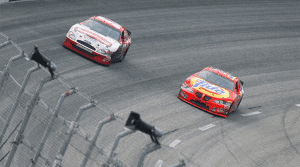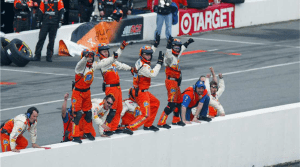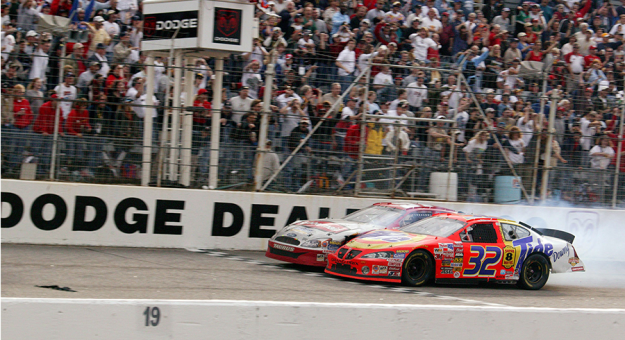As NASCAR celebrates the rich history of stock car racing this weekend at Darlington (S.C.) Raceway, it presents an opportunity to remember one of the most iconic finishes the sport has ever seen.
It was March 16, 2003, when Ricky Craven and Kurt Busch treated fans at The Track Too Tough To Tame to the battle of a lifetime.
After two laps of hard-nosed racing, Craven edged Busch to the start/finish line by .002 seconds.
While 20 years have passed, the legacy of the race rages on.
The Setup
Heading into Darlington in 2003, Craven and Busch had different mindsets.
For Craven, the spring event at the 1.366-mile egg-shaped oval was set to be a redemption story. Craven, who was driving for Cal Wells’ PPI Motorsports, earned the pole a year prior but wrecked out of the lead after battling with Steve Park.
“I did not know how to win at Darlington, and nor did Steve, who’s a good friend,” Craven told SPEED SPORT. “We wrecked trying to lap a car. I was so disgusted.”
Craven, needless to say, was chomping at the bit to get another shot of victory at Darlington.
“It stuck with me for the next 12 months,” Craven admitted. “It really ate at me that I just did such a poor job managing the race.”
On the flip side, second-year driver Busch was trying to find the right feel for his race car as race day loomed.
Busch’s weekend, however, started off in the worst way.
“What’s unique about my race was, we blew, I think, two or three engines in practice,” Busch said.
Though his engine woes would come to an end before qualifying.
As the field took the green flag for the 400-mile race, Busch started sixth, while Craven was mired back in 31st.
Despite what the time sheets stated, the driver of the No. 32 Tide Pontiac was optimistic.
“I remember talking with Scott Miller (crew chief) after the practice on Saturday, and he said ‘OK bud, what do you need?’ I said, ”I’m good.’
“He goes, ‘We’re not good.’ And I said, ‘No, we’re OK, this car does not slow down,’” Craven recalled. “I can’t say I had as much confidence as I had the year before, but I was at peace.”
The Moment The Gloves Came Off
The ebbs and flows of the race brought plenty of contenders to the front. But when Busch sneaked past Jeff Gordon and Elliott Sadler, who had abused their tires, to take the lead with 23 laps remaining, the dramatic conclusion began to take shape.
“When they were side-by-side off turn two, I went three-wide down the back straightaway, and I took the lead,” Busch said. “Then I remembered, ‘Oh, well, you’re supposed to just race the race track.’
“So I just had to run and hide and get away from everybody, because I didn’t know anything different.”
As Gordon and Sadler faded, Craven’s Pontiac came to life. Craven surged from fifth to second, and the race was on.
“There were 20 laps to go and I had Kurt in my sights and they were giving me lap times,” Craven said. “I knew that I was about three tenths of a lap faster.”
Little did Craven know, Busch’s power steering was beginning to give out, making it a handful for Busch to hang on.

“I’m wheeling this thing. I’m wheeling it and I see in the mirror Ricky Craven’s catching me,” Busch said. “I go, ‘He doesn’t know that I’m losing power steering fluid. I’m just gonna hold him off when he gets here.'”
With two laps to go, Craven caught the back of Busch’s No. 97 Ford.
“When I got to him, I felt it was going to be an easy pass,” Craven admitted.
To Craven’s dismay, Busch only raced harder during the closing stages of the race.
“With two laps to go we went into turn one side-by-side, he didn’t lift, I didn’t lift,” Craven said. “I slid sideways, made contact with Kurt and put him in the wall.”
Like a rattlesnake, Busch made short work of Craven’s move, snapping right back and putting Craven in the wall.
“‘Well, if you’re gonna put me in the fence, now I’m gonna jack you up, I’m gonna move you and I’m gonna get back by you,’” Busch said.
Craven knew he only had one chance to win the race.
“With a lap and a half to go I had to regain my composure, and then really came to the conclusion that, ‘I’m going to have one more shot at this.’” Craven said. “That would be off turn three and four on the last lap.”
The Finish Of A Lifetime
Craven chased Busch back down on the final lap, setting up the No. 32 with a massive run between turns three and four.
Without power steering in the tighter section of the race track, Busch was a sitting duck as Craven creeped up to the No. 97’s left side door.
Coming off the final corner almost in unison, both drivers collided.
Nearly 400 miles of action had led to a quarter-mile drag race.
“I remember doing it, but I don’t remember turning right, because the back tires were sliding, and then turning left because the front tires were sliding,” Craven said.
“I remember I never lifted off the gas pedal. I know he didn’t because I heard both engines were roaring and sort of stalling when we made contact, but neither of us lifted. So that I know for certain.”
After wheeling his car for nearly 20 laps without power steering, Busch couldn’t hold on any longer.
“I couldn’t hold the wheel anymore, our cars locked together,” Busch recalled. “Legitimately I didn’t go to block him. Our car’s locked together because I ran out of muscle to hold the wheel.”
With the fans on their feet, Craven and Busch barreled to the start/finish line virtually even.

Though as both drivers looked at the scoring pylon out their window nets during the cool down lap, it was Craven’s No. 32 who was shown as the winner.
“I knew that I had lost, but I still hoped that I won,” Busch said. “When we went over to turn two down the back straightaway, I was looking at the scoring pylon through my side window net.
“It said 32 ahead of the 97. I’m like, ‘Man, maybe Jimmy Fennig (crew chief) is going to radio to me.’
“Then Fennig said, ‘We’re second.’ I’m like, ‘Yep. Yeah, we are.’ I failed my team, I lost the race.”
Busch’s mindset quickly pivoted as he headed to pit road, understanding the significance the fantastic finish.
“But I knew something special had happened,” Busch said. “It was one of the coolest moments of ever finishing second, that I think a driver could feel.”
As Craven tried to process the win in victory lane, he was notified that Busch was on his way. Craven admittedly was skeptical of what Busch’s intentions were.
“I expected that it could be heated,” Craven said. “When he got within 10 feet of me, he stuck his hand down and said, ‘That was amazing.’ We embraced, high-fived, and we’ve truly been celebrating it ever since.”
From that moment on, the two have held a special bond.
Why It Continues To Be Special
The finish became an instant classic, with two drivers competing wheel-to-wheel, refusing to lose.
Craven believes the mutual respect given during the heat of battle is what stands out years later.
“From a purist standpoint, I think the reason people remember the race is because it was the equivalent of a bottom of the ninth inning walk-off home run,” Craven said.
“Had either of us wrecked one or the other with a lap to go or three laps to go, there’s really nothing to celebrate 20 years later.”
It was Craven’s last Cup Series victory, as he retired in 2006.
For Busch, a Hall of Fame worthy résumé was only beginning. One year later, Busch was crowned the 2004 Cup Series champion.
As the Cup Series heads to Darlington this weekend, Craven and Busch will be the honorary starters for Sunday’s Goodyear 400 at Darlington to help celebrate the 20th anniversary of the historic finish.
Even after 20 years, the appreciation and stories from fans still come to light for Craven.
“Everywhere I travel, if people have never met me, they give me their perspective of those last two laps,” Craven said. “It’s so cool, they don’t really ask me my perspective, because they saw it. They witnessed it, and they can replay it over and over.
“They might ask what I was thinking, but they give me how they tipped over the coffee table, or how they jumped up and down on the couch, how they high fived one another, or how they celebrated for 30 minutes after the race about how friggin’ cool that finish was.”
To this day, Craven and Busch’s duel is tied (2011 spring Talladega (Ala.) Superspeedway) for the closest finish in NASCAR history.
Follow @DHoffmanMedia22